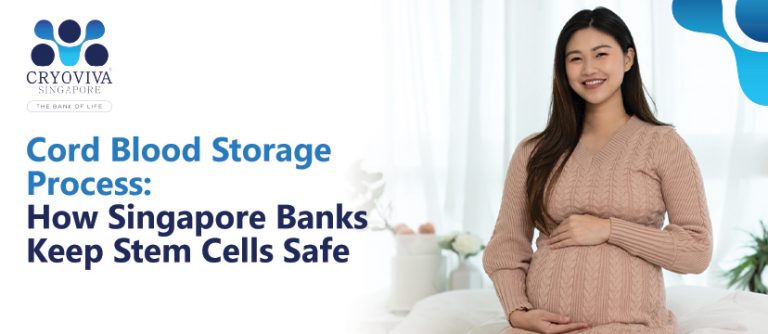Blog
Cord Blood Storage Process: How Singapore Banks Keep Stem Cells Safe

Impressive, you’ve made a smart decision to preserve your baby’s stem cells through private cord blood banking. And rest assured, this decision of yours is the best gift for your baby’s healthy future.
To store your baby’s cord blood, you’ve got your cord blood collection kit ready in your hospital bag. However, what if your banking partner doesn’t store it correctly? The stem cells could compromise their health value completely. That’s why it’s so crucial to choose a trusted partner like Cryoviva Singapore, where the cord blood is processed through an FDA-cleared, fully automated, and closed system by an experienced technical team in our Ministry of Health (MOH) licensed facility.
Read this blog to know how the cord blood storage process actually works and how Cryoviva keeps your baby’s precious stem cells safe for the future.
What is the Cord Blood Storage Process
Parents in Singapore can store their baby’s cord blood in a private blood bank to ensure that only their family can use it. This decision is helpful for families with a history of health issues that can be addressed with stem cells. It’s also advantageous if a family member currently needs a stem cell transplant.
That’s why you should choose a reliable private bank to store the cord blood containing valuable stem cells for future health benefits.
Here is the cord blood storage process:
-
Collection (Just After Delivery)
Immediately after childbirth, the umbilical cord is clamped and cut, and a healthcare professional draws blood from the cord through a sterile needle. This collection process is completely safe for both mother and baby and requires just a few minutes.
-
Safe Sealing & Labeling
Technicians at Croviva Singapore collect and place cord blood in a special sterile collection bag. Afterward, it’s carefully labeled with your baby’s and mother’s details to guarantee accurate tracking and identification.
-
Shipping to the Cord Blood Bank
The collection bag is securely packed in a temperature-controlled kit and delivered to the storage facility, generally within 24 hours, so that the quality of the stem cells is maintained.
-
Cord Blood Screening & Testing
At the lab, the cord blood is tested for infections, blood type, and cell count to make sure the collected sample is healthy and ready for future use.
-
Processing and Separation
The lab separates stem cells from the red blood cells and plasma. The latest technologies, including the AXP® II System, ensure quality in sample processing. This results in a higher yield of cell count, and the stem-cell-rich portion is safely extracted.
-
Storage With Cryogenic Freezing
Finally, the stem cells are wrapped and sealed in cryo-bags. Then they are frozen at ultra-low temperatures (frozen under -196℃) using liquid nitrogen. They remain preserved for years to come and can be retrieved whenever needed for treatment.
Note: The FDA doesn’t regulate private cord blood banks. But a reliable private bank follows a legally approved standard procedure.
Safe Preservation Standards
A reliable private cord blood bank must have the following qualities:
- Possesses AABB Accreditation for both Cord Blood and Cord Tissue preservation
- Uses the FDA-cleared, functionally closed automated system (AXP® II) that provides the highest standards of processing for maximum recovery of cell count and vitality.
- The processing and storage should be done by an experienced technical team in a Ministry of Health (MOH) licensed facility.
- The Lab should be strategically located in Central Singapore (Bishan).
Cryoviva Singapore has all of the above-mentioned qualities. Additionally, if the cord blood unit stored is not found viable for transplant, they facilitate arranging the best available matched cord blood unit to meet the costs of obtaining a matching sample.
How Long Can Cord Blood Be Stored?
While there is no known expiration date, cord blood can be stored for 23.5 years without any change in its properties.
Benefits of Cord Blood Storage
The cord blood storage process has the following benefits:
- It’s a painless method to store beneficial stem cells that can save lives later.
- It has the potential to treat 80+ serious diseases such as cancer, anemia, and immune problems.
- Storing cord blood means giving your family peace of mind if a matching stem cell is required in the future.
- The stem cells (haematopoietic stem cells) are young and flexible, contributing to effective and safe treatments.
- Many cord stem cell treatments are FDA-approved and support new therapies as medical science advances.
Take-Home Message
Once the decision to preserve your baby’s stem cells is made, it’s crucial to choose a reliable, accredited cord blood bank like Cryoviva Singapore that follows medical safety and testing standards and uses the latest technology, like the AXP Processing Bag Set. This ensures the collection bag is managed properly and the stem cells remain healthy. Contact us today so that you can confidently use it in the future for possible treatment when needed.
FAQ's
Cord Blood contains Hematopoietic Stem Cells that help manage blood diseases, while Cord tissue is composed of mesenchymal stem cells that may repair nerves, bone, and muscle.
Cord Blood Stem Cell banking means safely collecting and storing your baby’s cord blood. This blood is enriched with stem cells that can be used later for possible disease treatments if required.
The whole collection and storage are safe for both mother and baby. This process generally takes a few hours after childbirth, and the stem cells can be preserved for possible future use.
Cord Blood can remain frozen (Temperature under -196℃), still healthy and usable. After 18 years, ownership may transfer to the child after adulthood.


